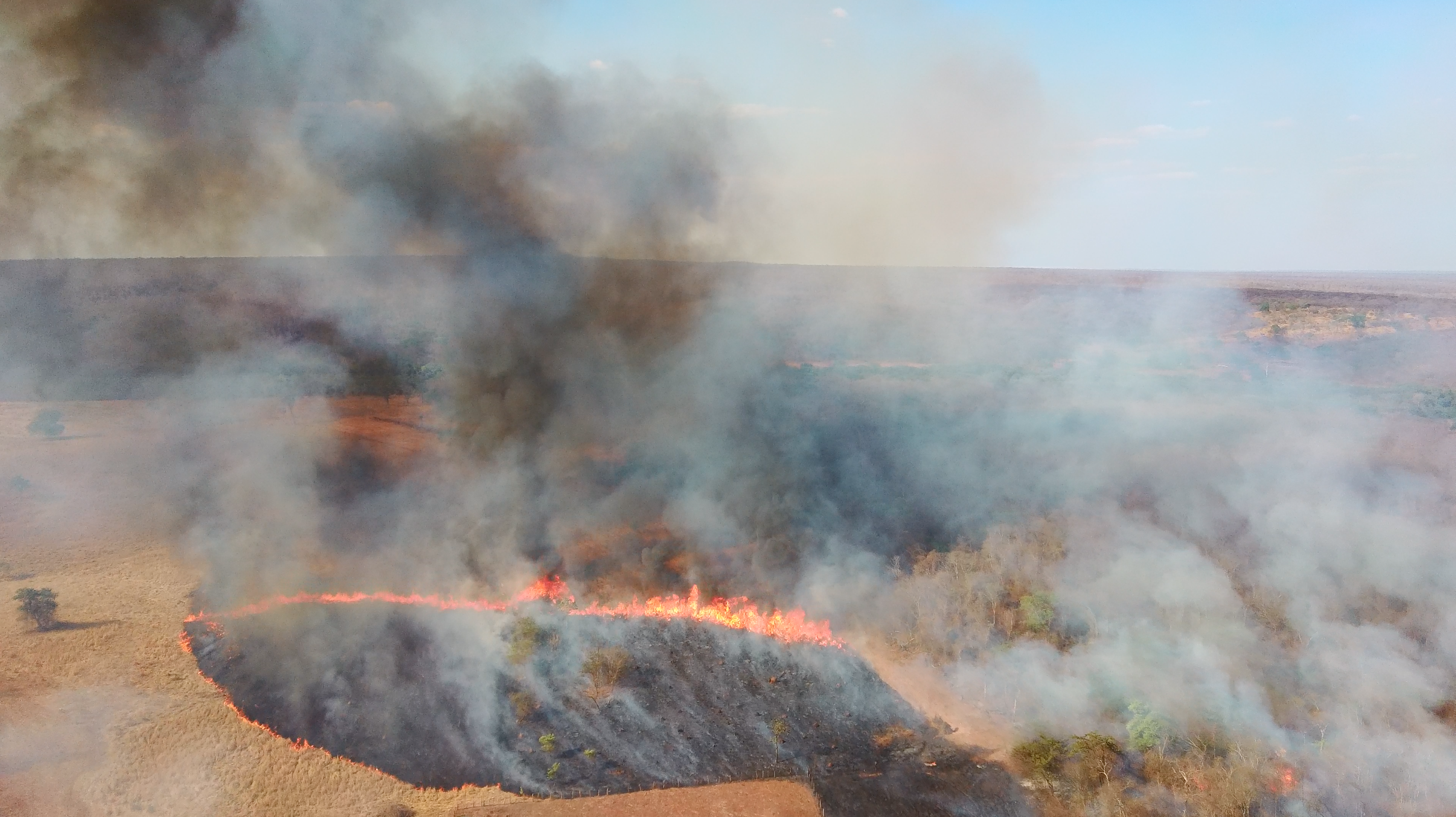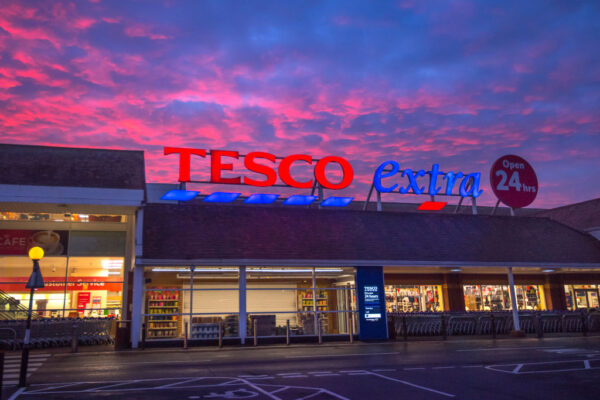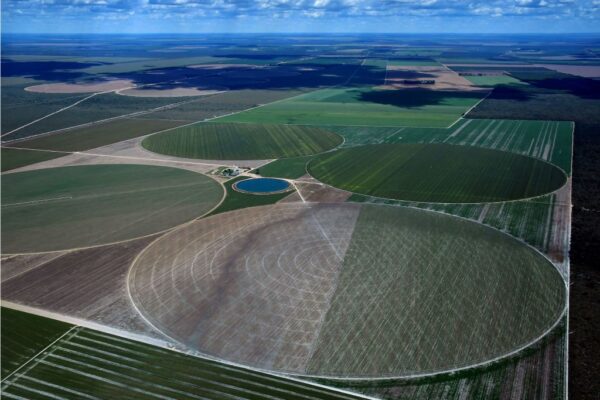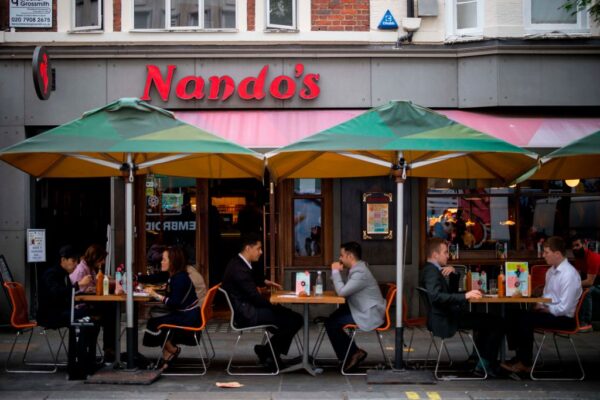
Fires on Fazenda Parceiro, owned by SLC Agricola, in the Cerrado's 'most deforested municipality' in October 2020. Photo: ITV/TBIJ
Soya linked to fires and deforestation in Brazil feeds chicken sold on the British high street
Brazil's vast tropical woodland is being consumed by soybean production used for animal feed
Soya linked to fires and deforestation in Brazil feeds chicken sold on the British high street
Brazil's vast tropical woodland is being consumed by soybean production used for animal feed
Fires on Fazenda Parceiro, owned by SLC Agricola, in the Cerrado's 'most deforested municipality' in October 2020. Photo: ITV/TBIJ
This story is published in collaboration with the Bureau of Investigative Journalism, the Guardian, and ITV News.
Britain’s leading supermarkets and fast food outlets are selling chicken fed on soya that has been linked to vast deforestation and thousands of fires across a vital region of tropical woodland in Brazil, an investigation has revealed.
Tesco, Asda, Lidl, Nando’s, and McDonald’s source chicken produced in the UK by the agribusiness giant Cargill – America’s second biggest private company. It is estimated that Cargill ships more than 100,000 tonnes of soybeans to the UK every year from Brazil’s threatened Cerrado savannah.
Though less well known than the Amazon rainforest to its north, the Cerrado is an enormous natural biome, covering two million sq km of land. It is a major habitat for wildlife – home to 5% of the world’s plant and animal species – and a critical region for tackling climate change. It is also under increasing threat from industrial food production.
An investigation by Unearthed and a coalition of reporting partners has revealed the complex supply chains that bring this soya to the UK – much of it from the deforestation hotspot of the Cerrado, where allegations of land-grabbing, violence, and deforestation have been rife.
Exclusive figures obtained from Aidenvironment, a non-profit research consultancy, reveal 800 sq km of deforestation and more than 12,000 recorded fires since 2015 on land used or owned by a handful of Cargill’s soya suppliers in the Cerrado. Fires are often set to clear woodland and aid agricultural expansion. Footage obtained in the investigation shows huge fires burning on a farm belonging to one of Cargill’s suppliers in October.
Cargill said it broke no rules, nor its own policies, by sourcing from the farm in question and made clear it does not source from illegally deforested land.
The broadcaster and campaigner Chris Packham said the revelations showed that consumers needed to be given more information about their food. “Most people would be incredulous when they think they’re buying a piece of chicken in Tesco’s which has been fed on a crop responsible for one of the largest wholesale tropical forest destructions in recent times,” he said.
“We’ve got to wake up to the fact that what we buy in UK supermarkets, the implications of that purchase can be far and wide and enormously damaging, and this is a prime example of that.”
Video: Georgie Johnson and Sian Butcher
The findings come as the British government is proposing new legislation, aimed at stamping out deforestation in British supply chains, that would make it illegal for companies to import foodstuffs linked with any illegal environmental destruction in the source country.
Campaigners and politicians say the legislation needs strengthening because it would potentially omit areas – including the Cerrado – where local laws permit significant deforestation.
“Voluntary commitments … from the private sector just don’t work, which is why we need robust UK legislation,” Kate Norgrove, director of campaigns at WWF-UK, said. “Although an important first step, the proposed approach to due diligence, relying on local laws, will not be enough. We need a legally binding UK target to end all deforestation and habitat destruction in precious landscapes like the Cerrado through our imports.”
Neil Parish, the Conservative chair of the environment select committee, said he welcomed the government’s proposals, “but this investigation shows legal deforestation is widespread, ingrained and endemic in our supply chains”.
A spokesperson for the Department for Environment, Food and Rural Affairs said the proposed legislation was one piece of a “much larger package of measures” to tackle deforestation. “Businesses must take greater responsibility for ensuring the resilience, traceability and sustainability of their supply chains.”

McDonald’s, Asda, Lidl, and Nando’s do not publicly say where the soya in their supply chains originates from, though Nando’s told the investigation team that its soy is from Brazil and Paraguay. Tesco states that some of the Cargill soya in its supply chains comes from the Cerrado but in 2019 it told Greenpeace it does not know the origin of much of the product it uses.
The supermarkets and fast food chains all said they are committed to tackling deforestation in their supply chains but acknowledged there was more work to do. All these corporations recently wrote to the government in support of the proposed legislation and urged that it be expanded to cover locally legal deforestation too.
Some argue the only way to get companies to act is by applying public pressure. “It’s vital that pressure is applied to Cargill, but also to the household names like Tesco, Asda, McDonalds, and Nando’s if they are using soya from deforestation hotspots for their chicken,” said Parish. “Naming and shaming these companies is an important tool in our armoury, and our consumers deserve to know.”
Ten years ago Cargill set itself a deadline of 2020 to eliminate deforestation in its supply chains of key commodities such as soya, but admitted last year it would not be met. It has pushed back its deadline to 2030 instead. McDonald’s has given itself until 2030. Experts have repeatedly warned this is far too late.
A final refuge for wildlife
While the Amazon rainforest has become the focus of global environmental concern in recent decades, its neighbouring Cerrado region remains largely unknown to the outside world. Yet despite being much smaller than the Amazon, it has lost more of its vegetation over the 10 years to 2018, and today only half of its original cover remains.
The Cerrado’s trees, shrubs and plains are estimated to store the equivalent of 13.7bn tonnes of carbon dioxide – significantly more than China’s annual emissions. The savannah is considered a crucial part of South America’s water system and is home to many Indigenous communities as well as endangered animals, including jaguars, giant armadillos and giant anteaters. It provides a habitat for more than 4,800 species of plants and animals found nowhere else on the planet.
But although traders and international NGOs agreed a ban on felling trees in the Amazon for soya production in 2006, no such agreement has ever been reached for the Cerrado. While beef production continues to drive Amazon deforestation, soya is doing the same in the Cerrado, with the region estimated to account for 90% of soya-driven deforestation in Brazil.
Global exports of Brazilian soya were linked to 500 sq km of deforestation in 2018, according to the supply chain expert Trase. Cargill is one of the world’s biggest exporters of Brazilian soya, alongside another American trader, Bunge.
Last year, Cargill publicly opposed proposals for a Cerrado soya moratorium similar to that in the Amazon. Instead it announced $30m of funding for efforts to address deforestation, but did not specify what this would be spent on. According to Reuters, in 2018 the Brazilian government’s environmental agency, Ibama, fined Cargill for trading soya originating from illegally deforested areas in the Cerrado.

Cargill said it is “committed to nourishing the world in a safe, responsible and sustainable way” and that it is aiming to build a deforestation-free soya supply chain. It added: “Cargill estimates that 96% of our soya volumes in Brazil for the 2018-19 crop year were deforestation-free … Cargill does not and will not supply soya from farmers who clear land in protected areas.”
The former president of Ibama, Suely Araújo, said ruling out deforestation in legally protected areas was not enough. “The rules that regulate agriculture in the Amazon are much stricter than those related to the Cerrado,” she said. “The mega-companies that commercialise the production of soya and other products from Brazil … must work with robust requirements from their suppliers and this, in some regions, implies going beyond the fulfillment of the legal rules.”
Brazil’s farming frontier
This August, the investigation team tracked the journey of a bulk tanker, the BBG Dream, as it left Cotegipe port near the Cerrado carrying 66,000 tonnes of soybeans on a journey that included a stop into Liverpool docks. The team was able to confirm that Cargill had leased the ship and that the beans on board were from the Cerrado’s hard-hit Matopiba region – including from the heavily deforested municipality of Formosa do Rio Preto.
Some of the ship’s beans were originally supplied by Bunge and another trader, ADM, but trade data shows all the beans were unloaded into Cargill’s soya plant in Liverpool.
Matopiba is Brazil’s newest soya frontier, an expanding agricultural powerhouse that has driven Brazil’s record soya harvests. An exclusive new analysis by the Dutch NGO Aidenvironment has found vast deforestation and fires on land used or owned by nine Cargill suppliers in the Cerrado, mainly in Matopiba.
Some of these farms are in Formosa do Rio Preto, a municipality notorious for alleged land-grabs and violence, and for its rapid transformation from a lush biodiverse savannah into the site of many sprawling monoculture soya fields.
On just one farm in the area, Fazenda Parceiro, more than 50 sq km of vegetation was razed in the first three months of 2020 alone, according to the sustainability risk analyst Chain Reaction Research. Cargill has confirmed that it sources soya from this farm, which is owned by SLC Agrícola, one of Brazil’s biggest soybean producers. SLC runs 17 large farms in Brazil, 10 of which are in Matopiba. More than 210 sq km of deforestation has been recorded on SLC Agrícola farms since 2015 – a total area roughly twice the size of Bristol.
Huge fires were spotted burning on Fazenda Parceiro as recently as early October and were estimated to have affected at least 65 sq km of land. There is no evidence to suggest the farm started these.
Timelapse satellite image showing deforestation in the municipality of Formosa do Rio Preto, western Bahia state, Brazil.
A former Fazenda Parceiro employee interviewed for this investigation said the company was under intense pressure to address deforestation in its production. In September, SLC Agrícola said the company would stop engaging in deforestation from 2021 onwards but admitted it still planned to clear around 50 sq km before the end of this year. SLC Agrícola declined a request for comment.
On another soya-growing estate, which is one of the largest in the area and not part of the new data analysis, last year Greenpeace Brazil filmed guards seemingly threatening villagers with guns.
In the UK
Once Cargill’s soybeans from Matopiba arrive on UK shores, they are processed at its soya crushing plant in Liverpool for use in animal feed. The plant sends the processed soya to Cargill’s poultry feed mills in Hereford and Banbury. Cargill runs its UK chicken operations under the banner Avara, a joint enterprise with the British producer Faccenda.
The soya is mixed with wheat and other ingredients at the feed mills, then taken to Avara’s contracted chicken farms. Identifying a typical case, the investigation established that the Hereford mill supplies a nearby farm that sends birds on to McDonald’s. Avara also supplies chicken to Asda, Lidl and Nando’s, and is the largest fresh chicken supplier to Tesco.

Avara said it has committed to eliminate deforestation in its soya supply chain by 2025. It said it is exploring ways to reduce its dependency on imported soya and that the issues raised by the investigation would only be combated by “continuing to work across the full supply chain to improve transparency”.
The findings highlight how even homegrown livestock has a global environmental impact. The UK slaughters a billion birds – the equivalent of 15 per person – every year and according to one estimate, chickens account for around 60% of the UK’s imported soya consumption.
McDonald’s serves meals to 3.5m customers a day in the UK, including McNuggets, Chicken Legends and McChicken sandwiches. It has admitted that 14% – a seventh – of the soya used in its chicken feed was not covered by any sustainability certification; the rest is covered by buying credits – similar to carbon offsetting – or other schemes. The credits support farmers producing sustainably but the actual soya in the retailers’ supply chains can still come from deforesting farms.
A McDonald’s spokesperson said: “We’re proud of the progress we’ve made, yet recognise there is more to do. […] An effective approach will require strong collaboration between governments, civil society and the private sector.”
Nando’s, which also uses a credits system, said: “We recognise that there is more work to do, which is why we are also investing in research looking at more sustainable feed alternatives.”
Several British supermarkets including Asda and Lidl say they are working towards buying 100% “certified” soya by 2025. Asda said: “We understand the importance of sustainable soya to our customers and are committed to reducing food production linked to deforestation.”
Lidl GB said it is committed to sourcing sustainable and deforestation-free soya and that it was the first supermarket to cover its entire soya footprint with sustainability credits. Tesco said it has set an “industry-leading target” for its soya to come from verified “deforestation-free areas” by 2025.
“Setting fires to clear land for crops must stop,” a Tesco spokesperson said. “We are working with partners including WWF to build the industry-wide support needed to deliver this.”
Last year, Tesco committed £10m in funding to help find a solution to soya deforestation in the Cerrado. McDonald’s, Nando’s and the three supermarkets named have publicly expressed their support for a new moratorium, like that in the Amazon, to restrict deforestation for soya in the Cerrado, but opposition in Brazil has so far been successful. Cargill has publicly said it opposes a further moratorium.
Global soya supply chains are complex and opaque. The beans from different farms are often mixed together, and buying carefully segregated sustainable product is costly and rare, so retailers rely on certification schemes that promise to offset their environmental damage.
Nando’s, Asda and Lidl use credits, the most basic certification tier that involves purchasing offsets for every tonne of soya they use. The money supports farmers producing sustainably, but the soya in the supply chain is not necessarily deforestation-free. McDonalds also says it uses credits, among other schemes.
The next tier up, which Tesco has set as a goal for the end of 2020, is known as “mass balance”. This means it restricts its buying to suppliers who grow at least some sustainable soya. The supplier may mix this in with beans from deforested farms, but under mass balance, Tesco and its meat suppliers would only purchase a volume of the crop that matched the amount of sustainable soya that went in.
Critics call these schemes greenwashing that allow logging to continue. The retailers say they help fund progress towards less destructive farming, but almost all admit that more needs to be done – albeit in five or ten years’ time.





